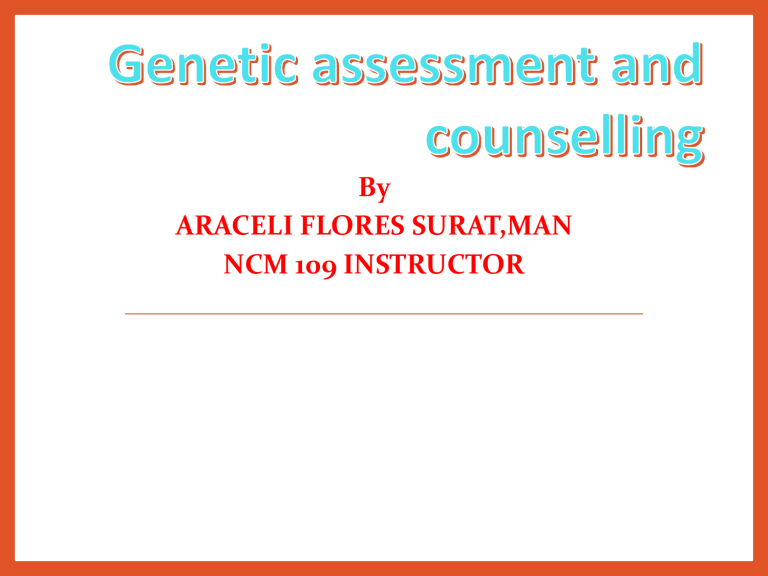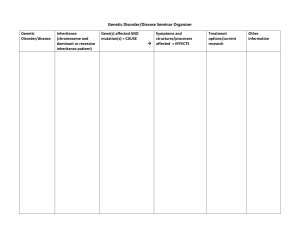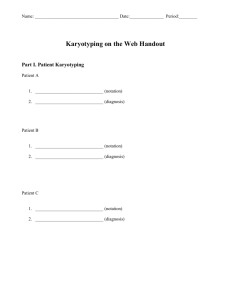
By ARACELI FLORES SURAT,MAN NCM 109 INSTRUCTOR ⚫Genetics- a branch of biology concerned with the study of genes, genetic variations and heredity in living organism. ⚫Genetic counselling- is a process of communicating between two or more persons who meet to solve a problem, resource a curse or take decisions on various matters. It is not a one way process where in the counseling tells the client what to do nor it is a forum for presentation of the counselor’s value ⚫Is the process of advising individuals and families affected by or at risk of genetic disorders to help them understand and adapt to the medical, psychological and familial implications of genetic contributions to disease other terms: ⚫Phenotype – refers to outward appearance of the expression of genes ⚫Genotype – refers to actual gene composition ⚫Genome – complete set of genes present ⚫ Normal genome ; 46XX/46XY ⚫Genetic disorders – disorder passed from one generation to the next ⚫Occur in same ethnic group ⚫Occur at the moment an ovum and sperm fuse or even earlier in the meiotic division phase of the ovum or sperm when the chromosome count is halved from 46 to 23. Methods of Assessment A. History Taking ✔ Include any one related to the family ✔ Maternal age (> 35 y/o) ✔ Paternal age (>55y/o) ✔ Document parents if consanguineous/related to each other ✔ Document ethnic background ✔ Extensive prenatal history B. Physical assessment • Pay particular attention to the space between the eyes, height, contour, shape oe ears, number of fingers and toes, presence of webbing(syndactyly) ⚫DERMATOGLYPHICS – study of surface markings of the skin : Down syndrome/Trisomy 211 Code: 47XXY21/47 XY21 Characteristics Late closure of fontanelle Slant eyes Epicanthal fold (extra fold of tissue at the inner cannula ) Brush field spots ( iris with white specks) Large tongue Low set ears Small mouth cavity Back of the head is flat Neck is short Extra pad of fat at the base of the head causes the skin to loose Poor muscle tone ( rag-doll appearance) Fingers are short and thick Little finger is often curved inward Wide space between the 1st and 2nd finger and toes Palm- with one single horizontal simian crease Small head Brain is not well developed IQ= 50-70 Prone for infection Clinodactyly Abnormal dermatoglyphics Trisomy 18 / Edward’s syndrome Code: 47XY18/47XX18 Characteristics have copies of chromosome 18 - do not survive beyond early infancy. Microcephaly Severely cognitively challenges SGA at birth Marked low set ears Small jaw Congenital heart defects Misshapen fingers and toes (index fingers deviates or cross over other finger) Multiple hair whorls Fragile X syndrome (Code: 46XY23q) Characteristics Most common cause of cognitive challenge in males -An X linked disorder in which 1 long arm of an X chromosome is defective - before puberty: displays maladaptive behavior such as hyperactivity and autism Bossing (prominent forehead) Prominent lower jaw Large hands Marked deficit in speech and mathematics/problem solving Large head Long face Large protruding ears After puberty: enlarged testicles Turner syndrome Code: 45X0 characteristics Has only 1 functional X chromosome Low set hair line Webbed neck Can be identified with an UTz during Gonadal diagenesis pregnancy because of the increase Short in structure neck folds. Has only streak (small and nonfunctional) ovaries Sterile Exception of pubic hair; secondary sex characteristics do not develop at puberty Newborns= edema on the hands and feet With coarctation (stricture) of aorta and kidney disorder Severely cognitively challenge Klinefelter syndrome Code: 47XXY characteristics Males With an extra X chromosome Absence of secondary sex characteristics Small testes- produces ineffective sperm Gynecomastia ( enlarged breast size) Increased risk of male breast cancer Trisomy 13/ patau syndrome Code: 47 XX13/47 XY13 Characteristics Has an extra chromosome 13 and cognitively challenged Most do not survive beyond early childhood Microcephaly Clip lip and palate Low set ears Multiple hair whorls Wide set nipples Rocker bottom feet Heart defects ( ventricular septal defect) Abnormal genitalia Small eyes (microphthalmus) C. Diagnostic testing Karyotyping sample of peripheral venous blood or a scraping of cells from the buccal membrane is taken Cells are allowed to grow until they reach metaphase- most easily observed phase Cells are stained, placed under a microscope and photographed Chromosomes are identified according to size, shape and stain is a test to identify and evaluate the size, shape, and number of chromosomes in a sample of body cells. Maternal serum screening Done at 15th week of pregnancy Alpha-fetoprotein (AFP)- a glucoprotein produced by the fetal liver Peak is between 13th and 32nd week of pregnancy RESULT: if elevated – it means spinal cord disease/ neural tube defects If below – it means chromosomal disorder/Down syndrome MSAFP (Maternal Serum Alphafetoprotein) CVS (Chorionic Villi Sampling) – a diagnostic techniques that involves the retival and analysis of chorionic villi from the growing placenta for chromosome or DNA analysis Commonly done at 8-10 weeks or 1012 weeks of pregnancy. May be done as early as 5 weeks. is a prenatal test in which a sample of chorionic villi is removed from the placenta for testing. The sample can be taken through the cervix (transcervical) or the abdominal wall (transabdominal). Amniocentesis withdrawal of amniotic fluid through the abdominal wall for analysis Done between 14th-16th week of pregnancy. A pocket of amniotic fluid is located by ultrasound (UTZ) A needle is inserted trans abdominally Aspirate 20 ml of amniotic fluid Client receives Rh immune globulin administration after the procedure (Rhogam) PUBS (Percutaneous Umbilical Blood Sampling) Other name: Cordocentesis Removal of blood from the fetal umbilical cord at about 17 weeks using an amniocentesis technique Fetal Imaging MRI and UTZ = used to assess a fetus for general size and structure disorder of the internal organs, spine and limbs GENETIC COUNSELING ⚫ Provide concrete, accurate information about the process of inheritance and inherited disorder ⚫ Reassure people who are concerned that their child may inherit a particular disorder that the disorder will not occur ⚫ Allow people who are affected by inherited disorder to make informed choices about future reproduction ⚫ Offer support on people who are affected by genetic disorder ⚫ observe data privacy. ⚫ ideal time for counseling is before 1st pregnancy ROLE OF A NURSE IN GENETIC COUNSELING ⚫Guiding women or couple through prenatal diagnosis ⚫Helping parents to make decisions in regards to abnormal prenatal diagnosis results ⚫Assisting parents whi have a child with a birth defect to locate needed service and support ⚫Providing support to help the family deal with the emotional impact of a birth defect ⚫Coordinate services of other professionals such as social workers, physical and occupational therapists, psychologist, dietatcian Importance of genetic counselling 1. Aid in determining the risk of disease 2. Help in identifying a hereditary condition 3. Assist in whether genetic testing is appropriate 4. Offer diagnoses and disease prevention and management 5. Offer emotional and psychological support, ethical guidance to help clients make well informed autonomous health care decisions and reproductive choices



